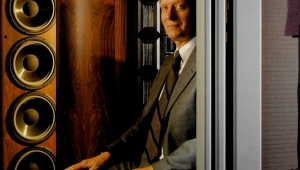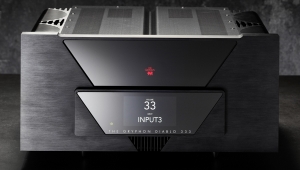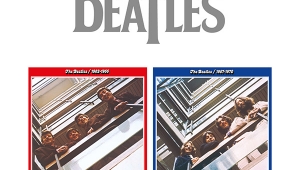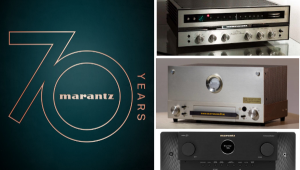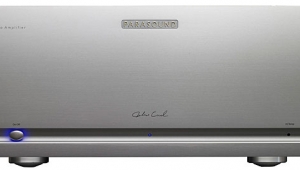| Columns Retired Columns & Blogs |
HE2005: Day 4, the Final Wrap
I've been thinking about women. All weekend long. While that, by itself, is nothing unusual for me, here at Home Entertainment 2005, I''ve been thinking particularly about the small number of female enthusiasts within the hobby of high-end audio.
"It's a male sport," says Moscode designer, George Kaye.
Ninety-eight percent," agrees Lorraine Janeway, president of Aperion Audio.
We're standing in Aperion's static display room, and I’ve just asked the question I’d been waiting all weekend for, without knowing who to ask before I was fortunate enough to meet Lorraine. And now, we’re starting to draw a crowd.
For me, the show started Wednesday evening with a fun, delicious dinner at China Grill. (If you ever go, you really have to try the wasabi mashed potatoes.) Sitting beside George at the table, I explained that this was only my second hi-fi show, and that I'm still relatively new to the hobby, still trying to figure it all out.
We’re not-so-slyly scanning the room for attractive women, when George turns to me: "I’ve only met three female audiophiles in my life. Women aren’t involved with music in the way that men are; they don’t dedicate themselves to listening. Men, also, are into tinkering, tweaking. We like to know that we can change things, change the sound— whether it sounds better or worse doesn’t really matter—as long as we know we’ve made the change. It’s about hearing differences."
Pick up the remote and fast-forward to Day Three: I’m sitting in the very impressive Innersound room, enormous Kaya loudspeakers emitting some of the most detailed music I’ve heard at the show, and Peter Clark of Red Point Audio at my side. Innersound’s Wes Bender introduces me as a musician, one who is just beginning to dive into hi-fi.
"This is about gear," Peter reminds me. "Music is music, and gear is gear. They’re two very different things. You have to keep that in mind. There’ll be times when you’ll forget that difference as you go deeper into the hobby."
Simple as that may sound, it’s sort of an epiphany to me. Right then and there, the question I have to ask begins to bloom.
But, first, there’s music to listen to. The room that I found myself in most often, the room that I came back to over and over again—sometimes under my own free will, other times unwittingly lured in by the music—was Naim’s. What got me in, initially, were the looks; clean, simple, thin, solid and sleek, Naim’s electronics and n-SATS speaker system would look nice, and actually fit, in my small Jersey City apartment. What kept me coming back was the music; Naim, in my indie rock-loving opinion, had the best and most unusual demo music of the show. They complemented more standard material like the Buena Vista Social Club and Neil Young with the slightly under-the-radar work of Andrew Bird, Ron Sexsmith, and Jack Johnson. I wandered by one late show evening, and was lucky enough to enjoy Bird’s entire Weather Systems. I was soon joined by another weary listener, who’d never heard Bird’s music before. Instantly, however, he became a fan. I was happy to share what I knew with him, and he was happy to listen.
A similar thing happened while I sat beside Adrian Butts in his Tetra room. Playing Jack Johnson’s On And On over the custom-painted Manhattan 305s, one showgoer after another was intrigued by Johnson’s music. "Who is this?" "Who’s playing guitar?" "Who’s singing?" "What album is this?" On and on again, they asked. It’s safe to bet that Adrian made as many fans of Jack Johnson’s music as he did of his own speakers, which, I bet, is simply a testament to the musical truth that the speakers delivered.
Speaking of "delivering musical truth" (did I say that?), it was on Saturday, April 16, that I saw my all-time favorite band —Sonic Youth—perform live at Hoboken’s very intimate Maxwell’s. To say the least, it was a show that I’ll never forget. Now, it was on Thursday, April 28th, that I was magically transported right back to that night, via John DeVore’s Silverback loudspeakers and Simaudio Moon amplification. Steve Shelley opens "Stones," from their latest album, Sonic Nurse, and—bass kick, hi-hat, tight snare hit—I was there, thinking to myself, "Holy crap!"
And then I told myself to shut up and listen.
I was at that Sonic Youth show with my good friend, Alexandra, and she loved it just as much—if not more—than I did. I stop to wonder now what she would think if she were there with me in John DeVore’s room, recreating that live event so vividly. I can’t imagine that she would be any less impressed.
Later, I walked into Aural Acoustic’s room where Paul Simon was singing about a woman with diamonds on the soles of her shoes. Though Aural's literature claims that its speakers offer the "most faithful and realistic music reproduction possible," the music here didn’t sound that lifelike to me at all, but instead sounded like something more magical; more like the images you might see at the Ziegfeld theater than the sights you’d see walking down Fifth Avenue. Not necessarily a bad thing, I decide. Until, that is, I offer Aural’s president, Spencer Clark, the latest Beck album, Guero, and ask him to play "Missing." I love this song when I play it through my Magnavox boombox at home, but through the beautiful Model B loudspeakers, all I could focus on was something that I’d never heard before, an ugly, crunching distortion that covered all of the music like a heavy, oppressive blanket. Spencer heard it too. He attributed it to the speaker’s highly sensitive tweeter: "It’s a Catch 22," he said. "The sophistication of the speaker can sometimes be very critical of the recording." I don’t blame it on the speaker. I blame it on Beck.
However, in the Totem room (which, incidentally, was happily decorated as a Native American teepee), I found myself very quickly wrapped up in the sound delivered by their small Rainmaker speakers, complimented perfectly by Ayre electronics. There was impressively big and fast sound, with powerful bass, coming from these small, relatively inexpensive ($950/pair) speakers.
"If the mids and highs aren’t there, then the bass won’t be there," Vince Bruzzese explained to me. "They go hand in hand." I nodded, and handed him Stephin Merrit’s Pieces of April soundtrack. The 6ths’ "You You You You You" sounded both lifelike and magical, and in the best possible way—the guitars sounding very natural and perfectly in place, while the lush female vocals seemed to come from somewhere higher above, somewhere heavenly.
In mid-track, I asked Vince to switch the cables over to the larger and more expensive ($2450/pair) Hawk loudspeakers. Strangely, after the speakers were swapped, I quickly reached for the remote and found myself raising the volume a few notches.
"For some reason," I told Vince, "I prefer the smaller speakers." He wasn’t surprised: "We set this system up to highlight the Rainmakers. The Ayre electronics here are better suited to the smaller speakers. The Hawks need a bit more power than the CX-7 CD player and AX-7 integrated amplifier (each ca $2900) can provide."
Perhaps I was beginning to learn a thing or two, but nothing as valuable as what I’d finally discover back in the Aperion static display room, one floor up. Lorraine Janeway has just finished giving me the rundown on her company’s products, not realizing that technical details and price points ("Our goal here is to deliver audiophile-quality sound at affordable prices...") were really not my thing, when she asks, "So do you have any questions?"
"Yes," I say, taking a deep breath. "I have a question. On Wednesday night, I had dinner with George Kaye from Moscode," I begin. "Do you know him?"
"That’s him there, isn’t it? Right behind you," she points him out.
I hadn’t even realized he was there, but now I know I have to ask: "Yes, um...awesome."
George walks over, and I continue, "Well, George was saying that the hi-fi hobby is generally a male thing...."
"Ninety-eight percent," she agrees.
"It’s very difficult for me to think that women simply don’t love music as much as men do. What George was saying was that part of the reason the hobby is so male-dominated is that it involves tinkering and tweaking, and that women and men go about the process of listening differently. I’ve been wondering what you think of that. Why aren’t there more women involved?"
"I’m glad you asked that," she says. And I’m relieved.
A small, interested crowd surrounds us to listen. Lorraine continues: "For women, the whole thing is about the creation of a total experience."
Before I can stop myself, I let out a short laugh. "What?" Lorraine asks.
"Nothing," I say. "It's like childbirth." Another woman nearby nods her head.
George chimes in: "Men, on the other hand, just don’t want to be made fools of. We want to control what's happening, and we want to know what's happening. I don't want to be made a fool."
Lorraine seems to agree: "Women are doing something with the music that is much different from what men are doing with it."
"Women aren’t listeners," George states bluntly.
At first, this declaration seems simple and crude, but I soon take it to mean that women listen differently—with a different goal in mind, rather than that they don’t listen at all.
"Men focus on one specific thing when they’re listening to music," says Lorraine. "They can zoom in on a specific aspect of it, and listening becomes the total experience. Men escape with the music, while women integrate the music into everything else around them."
"It's the exact opposite of how men and women interact in relationships," says someone within our small circle.
I laugh. It's another epiphany.
George continues: "In relationships, men are guests within a woman's world. Which is the exact opposite of what's happening in the listening room!"
Together now, we all laugh, shake hands, and make plans to discuss this further— sometime in the future, perhaps over dinner and music.
- Log in or register to post comments
